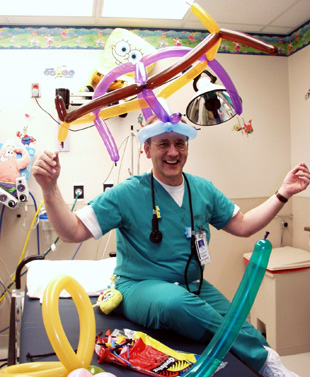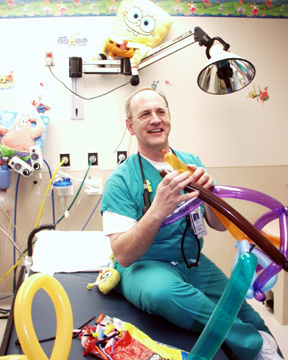 Tom Poulton, M.D., tries to take the pain out of bone marrow biopsies, lumbar punctures and bronchoscopies by clowning around. The UNMC professor of pediatrics and anesthesiology is an amateur clown, an activity he finds useful in working with pediatric patients.
Tom Poulton, M.D., tries to take the pain out of bone marrow biopsies, lumbar punctures and bronchoscopies by clowning around. The UNMC professor of pediatrics and anesthesiology is an amateur clown, an activity he finds useful in working with pediatric patients.
Dr. Poulton can be found clowning around with his young patients in the pediatric intensive care unit and surgical areas at the Nebraska Health System’s University and Clarkson hospitals. An amateur clown for about 20 years, his skills include juggling, simple magic tricks, creating animals and other interesting figures from balloons, and a well-honed sense of silliness.
“Most kids are tearful and apprehensive when they have to have procedures but when they see adults acting like children they think there’s something cool about it,” Dr. Poulton said.
Sharing his expertise
His expertise as a physician knowledgeable about the work of clowns earned him an invitation to speak at the annual meeting of the World Clown Association in Jacksonville, Fla., March 18-23. His presentation is titled, “Clowning for Children with Life-Threatening Illness” and “Occupational Health Update for Clowns.”
Dr. Poulton will share his experiences in dealing with the special challenges of working with children with life-threatening illnesses.
Helping children through play, silliness
“Clowns, like pediatric health-care specialists, generally select their work because they dearly love children,” Dr. Poulton said. “Working with children who are very ill is often quite stressful and sad. The sense of playfulness my pediatric co-workers enjoy sharing with patients and families is part of the essence of caring for children,” Dr. Poulton said.
 His presentation details appropriate coping mechanisms and the importance of remembering that all children, even those who are very ill, still like to play. Clowns, like many health-care specialists, help ill children express who they are through play and silliness, he said.
His presentation details appropriate coping mechanisms and the importance of remembering that all children, even those who are very ill, still like to play. Clowns, like many health-care specialists, help ill children express who they are through play and silliness, he said.
Occupational health issues for clowns
Dr. Poulton also will address more serious occupational health issues such respiratory risks posed by talcum powder clowns use in make-up, orthopedic injuries faced during tumbling and physically demanding skits, latex allergies associated with balloons, potential health consequences of balloons and the occasional infectious disease risks associated with working with children.
The World Clown Association has more than 2,500 members from every state and more than 10 countries, including professional and part-time clowns. Other speakers at the meeting will include many famous clowns as well as top clown-educators from around the world.
Kids respond in magical way
Dr. Poulton’s interest in clowning developed years ago when he worked with a medical student who skillfully crafted balloon animals for some of Dr. Poulton’s patients.
“I was instantly engaged by the magical way in which kids responded to that simple act,” he said.
Dr. Poulton, Sponge Bob put kids at ease
Dr. Poulton began studying the history of clowning and learned to juggle and took classes in clowning skills.
Linda Stone, a nurse in the NHS University Hospital Pediatric Intensive Care Unit, Dr. Poulton and their colleagues decorated the colorful procedure room with a “Sponge Bob” theme.
“It makes a huge difference to the kids,” Stone said. “It makes it much easier for them and less frightening. Dr. Poulton is absolutely wonderful with children. He puts them at ease. It’s quite amazing to see.”